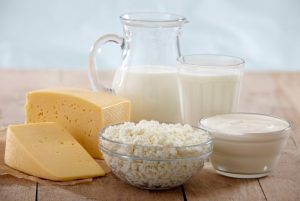What Causes Migraines And The Role Of Omega-3s In Prevention
Author: Dr. Stephen Chaney
 Migraines can be debilitating. And they affect millions of Americans. According to a recent survey 17.1% of women and 5.6% of men in the United States suffer migraine symptoms.
Migraines can be debilitating. And they affect millions of Americans. According to a recent survey 17.1% of women and 5.6% of men in the United States suffer migraine symptoms.
Symptoms range from frequent headaches to visual disturbances, nausea and vomiting, extreme light and sound sensitivity, brain fog, and debilitating pain. Sometimes all a migraine sufferer can do is retreat to a dark, quiet room and wait out the symptoms. This makes it virtually impossible to work, socialize, and interact with family.
For example, work absenteeism due to migraines is thought to cost US businesses up to $13 billion dollars annually. And, of course, there is no way to estimate the psychological cost of lost interactions with family and friends. And people who experience frequent migraines are more likely to suffer from depression, anxiety, and sleep disorders.
Medications can provide some relief from migraine symptoms, but they all have side effects. Various natural approaches for migraine relief have been proposed, but none of them are proven.
What Causes Migraines And The Role Of Omega-3s In Prevention
 Our understanding of migraines is complicated by the fact there appear to be multiple causes of migraines. It’s almost as if what we call “migraines” are really a variety of diseases with different causes but similar symptoms.
Our understanding of migraines is complicated by the fact there appear to be multiple causes of migraines. It’s almost as if what we call “migraines” are really a variety of diseases with different causes but similar symptoms.
Migraines can be triggered by:
- Hormonal fluctuations.
- Weather changes.
- Foods
- The top 3 food triggers of migraines are caffeine, red wine, and chocolate.
- Other common food triggers are artificial sweeteners, foods containing MSG, cured meats, aged cheeses, pickled and fermented foods, frozen foods, and salty foods.
- Stress
- Lack of sleep.
- Certain drugs.
- Missed meals.
Migraine triggers vary from person to person. And multiple neurophysiological pathways have been proposed to explain how each of these triggers progresses to a full-blown migraine.
To simplify a very complex subject, there are three main factors that influence each of these proposed pathways:
- Susceptibility to migraines clearly runs in families.
- 75% of migraine sufferers are women.
- Inflammation.
Because inflammation plays a strong role in progression and severity of migraines, there has been a strong interest in the use of long-chain omega-3s like EPA and DHA as nutraceuticals to reduce the frequency and severity of migraines.
However, previous studies have had mixed results. Some have suggested that omega-3s reduce the risk of migraines while others have come up empty.
The authors of the current study (H-F Wang, et al, Brain, Behavior, and Immunity 118, 459-467, 2024) postulated that some previous studies failed to find a benefit of omega-3 supplementation because they were too short in duration, used a mixture of omega-3s, or were poorly designed.
They noted that high dose EPA alone had proven to be effective in reducing the risk of heart disease and depression. So, they performed a 12-week randomized, double-blind, placebo-controlled clinical trial with migraine sufferers using 1.8 grams of EPA per day.
How Was This Study Done?
 This was a double-blind, placebo-controlled clinical trial, the gold standard for clinical studies. The investigators recruited 70 patients (15 men and 55 women) with episodic migraines (defined as migraines with or without aura occurring fewer than 15 days per month) from the neurology clinic of Kuang Tien General Hospital in Taiwan. The average age of the patients was 39 years old.
This was a double-blind, placebo-controlled clinical trial, the gold standard for clinical studies. The investigators recruited 70 patients (15 men and 55 women) with episodic migraines (defined as migraines with or without aura occurring fewer than 15 days per month) from the neurology clinic of Kuang Tien General Hospital in Taiwan. The average age of the patients was 39 years old.
The subjects were randomly assigned to use either 1.8 gm/day of EPA or a soybean oil placebo for 12 weeks. Both were formulated with an orange flavoring to hide the taste difference. Neither the patients nor the physicians conducting the study knew who got the EPA and who got the placebo.
The patients filled out an extensive questionnaire about their migraines and related issues at entry into the study and at the end of 12 weeks. They were also asked to maintain headache diaries for at least 4 weeks prior to the study and for every 4 weeks of the 12-week study. They received training from the study coordinator on how to fill out the diaries and were encouraged to contact the coordinator if they had any questions about how to accurately fill out the diary.
The primary outcome of the study was the decrease in migraine frequency from baseline to 12 weeks. The study also assessed changes in:
- Headache severity.
- The need to use headache medicines.
- Migraine-specific disability (The extent to which migraines resulted in disability).
- Migraine-specific quality of life index (The extent to which migraines affected the quality of life).
- Anxiety and depression (These are often side effects of chronic migraines).
While some of those outcomes appear to be overlapping, they are all well-established assessments used in migraine research. The questionnaire the doctors used was designed to provide a numerical rating for each of these outcomes.
Does EPA Reduce Migraine Frequency?
 As expected, there were no significant changes in the placebo group. But in the group taking 1.8 gm/day of EPA:
As expected, there were no significant changes in the placebo group. But in the group taking 1.8 gm/day of EPA:
- Migraine frequency decreased by 60%.
- Frequency that headache medication was needed decreased by 45%.
- Headache severity decreased by 14%.
- Sleep quality increased by 17%, but that increase was not statistically significant.
- Migraine-related disability decreased by 73%.
- Migraine-related quality of life improved by 31%.
- Anxiety and depression decreased by 53%.
These differences were statistically significant for the women in the study, but not for men – probably because of the small number of men in the study.
The study also assessed side effects from EPA supplementation in this group. Side effects were minimal and were not different from the placebo group.
The authors concluded, “High-dose EPA significantly reduced migraine frequency and severity. Improved psychological symptoms and quality of life in migraine patients, and showed no adverse events [effects], suggesting its potential for prophylactic use for migraine patients.”
They went on to say, “The results of this study may not only serve as a valuable reference for future large-scale randomized clinical trials to investigate the optimal dosing and components of omega-3 fatty acids for migraine prevention but also underscore the need for replication of these findings in adequately powered and controlled studies.”
In other words, this study needs to be confirmed by additional studies. And future studies need to determine the optimal dose of EPA and the optimal ratio of EPA to DHA.
What This Study Means For Us And For You
 The topic of omega-3s and migraines is of special significance for us. About 40 years ago my wife and I started taking a high purity omega-3 supplement containing both EPA and DHA to control inflammation. We didn’t have noticeable inflammation at the time, but we both had parents who suffered from rheumatoid arthritis and wished to avoid their suffering later in life.
The topic of omega-3s and migraines is of special significance for us. About 40 years ago my wife and I started taking a high purity omega-3 supplement containing both EPA and DHA to control inflammation. We didn’t have noticeable inflammation at the time, but we both had parents who suffered from rheumatoid arthritis and wished to avoid their suffering later in life.
In just a few weeks the migraines my wife had been experiencing for years disappeared. That piqued my interest, so I searched the literature and found several studies showing that omega-3 fatty acids reduce migraine symptoms. I have followed the twists and turns of omega-3 – migraine research ever since, which is how I came across this study.
As for our original purpose in taking an omega-3 supplement, all I can say is that we are now in our 80s, and neither of us suffer from the rheumatoid arthritis that plagued our parents.
And for my wife the disappearance of her migraines was an unexpected side benefit.
This study is a strong validation of the effect of omega-3s on reducing migraine symptoms. However, it is not the end of the story. As the authors said:
- It needs to be confirmed by larger, well controlled studies.
- The optimal dose of omega-3s needs to be determined.
- The optimal ratio of EPA to DHA and possibly other long chain omega-3s needs to be determined.
This study used 1.8 grams/day of pure EPA. My wife takes 3 grams of EPA and 2 grams of DHA each day. But we don’t know whether she would experience the same benefit from a lower dose or whether that is the optimal ratio of EPA to DHA. We do know that EPA and DHA have different health benefits, so we plan to continue taking a supplement that contains both.
And finally, as I said above, it is almost as if what we call migraines are really a cluster of diseases with similar symptoms. There are multiple migraine triggers and multiple proposed explanations of how these triggers lead to full-blown migraines.
So, we shouldn’t think of omega-3s as a magic bullet. Rather, we should think of them as one of many approaches that may provide you with some migraine relief.
The Bottom Line
A recent double-blind, placebo controlled clinical study with migraine sufferers reported that when they were given 1.8 gm/day of EPA for 12 weeks:
- Migraine frequency decreased by 60%.
- Frequency that headache medication was needed decreased by 45%.
- Headache severity decreased by 14%.
- Migraine-related disability decreased by 73%.
- Migraine-related quality of life improved by 31%.
- Anxiety and depression decreased by 53%.
The authors concluded, “High-dose EPA significantly reduced migraine frequency and severity. Improved psychological symptoms and quality of life in migraine patients, and showed no adverse events [effects], suggesting its potential for prophylactic use for migraine patients.”
They went on to say, “The results of this study may not only serve as a valuable reference for future large-scale randomized clinical trials to investigate the optimal dosing and components of omega-3 fatty acids for migraine prevention but also underscore the need for replication of these findings in adequately powered and controlled studies.”
In other words, this study needs to be confirmed by additional studies. And future studies need to determine the optimal dose of EPA and the optimal ratio of EPA to DHA.
For more details about this study and what it means for you read the article above.
These statements have not been evaluated by the Food and Drug Administration. This information is not intended to diagnose, treat, cure, or prevent any disease.
______________________________________________________________________________
My posts and “Health Tips From the Professor” articles carefully avoid claims about any brand of supplement or manufacturer of supplements. However, I am often asked by representatives of supplement companies if they can share them with their customers.
My answer is, “Yes, as long as you share only the article without any additions or alterations. In particular, you should avoid adding any mention of your company or your company’s products. If you were to do that, you could be making what the FTC and FDA consider a “misleading health claim” that could result in legal action against you and the company you represent.
For more detail about FTC regulations for health claims, see this link.
https://www.ftc.gov/business-guidance/resources/health-products-compliance-guidance
____________________________________________________________________________
About The Author
 Dr. Chaney has a BS in Chemistry from Duke University and a PhD in Biochemistry from UCLA. He is Professor Emeritus from the University of North Carolina where he taught biochemistry and nutrition to medical and dental students for 40 years. Dr. Chaney won numerous teaching awards at UNC, including the Academy of Educators “Excellence in Teaching Lifetime Achievement Award”. Dr Chaney also ran an active cancer research program at UNC and published over 100 scientific articles and reviews in peer-reviewed scientific journals. In addition, he authored two chapters on nutrition in one of the leading biochemistry text books for medical students.
Dr. Chaney has a BS in Chemistry from Duke University and a PhD in Biochemistry from UCLA. He is Professor Emeritus from the University of North Carolina where he taught biochemistry and nutrition to medical and dental students for 40 years. Dr. Chaney won numerous teaching awards at UNC, including the Academy of Educators “Excellence in Teaching Lifetime Achievement Award”. Dr Chaney also ran an active cancer research program at UNC and published over 100 scientific articles and reviews in peer-reviewed scientific journals. In addition, he authored two chapters on nutrition in one of the leading biochemistry text books for medical students.
Since retiring from the University of North Carolina, he has been writing a weekly health blog called “Health Tips From the Professor”. He has also written two best-selling books, “Slaying the Food Myths” and “Slaying the Supplement Myths”. And most recently he has created an online lifestyle change course, “Create Your Personal Health Zone”. For more information visit https://chaneyhealth.com.
For the past 45 years Dr. Chaney and his wife Suzanne have been helping people improve their health holistically through a combination of good diet, exercise, weight control and appropriate supplementation.





